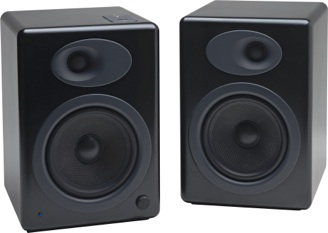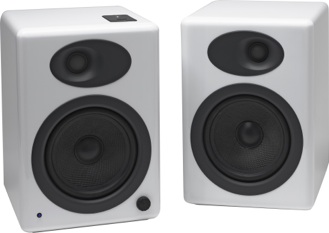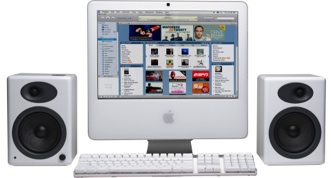TheDigitalMusicExperts.com (877)WiFi-HiFi
High Performance Music Systems for your 21st Century Digital Lifestyle (877) 943-4443
The development of the AudioEngine A5 is a very interesting story. What follows is a discussion of how the good folks at AudioEngine came up with the design of this exceptionally high value musical marvel:
The Audioengine team sits in a listening room hour after hour critically listening to all types of music from Bach to Van Halen. They settle in on a Bob Marley song and Brady gets another big grin on his face. It’s early fall of 2005 and they’ve just finished fine-tuning their first speaker system under the Audioengine name. Dave says the tuning is the hardest part, but admits that finishing up the cosmetic details before production will be the big challenge over the next few weeks.
In 2002, after a total of 36 years working in the audio industry for companies such as Harman/Kardon, Gibson Guitar, Alesis Studio Electronics, and Apple Computer, the founding team finally decided to launch their own audio company. Their goal was to design and build high quality studio monitor speakers at affordable prices for the pro-audio market, which is what they’ve been successfully doing for the past 3 years until something interesting happened, as Dave explains:
“When you design studio monitor speakers you tend to spend a crazy amount of time in sound rooms listening for how well the speakers reproduce the original recording,” Dave says, in his Mississippi drawl. “During one of our marathon speaker tuning sessions for a new monitor design, one of us mentioned that we ought to modify a model for home use. They had such a wonderful sound and even though they were studio monitors we agreed they would likely rival Brady’s favorite bookshelf speakers.” And after some basic design changes and tuning tweaks it turns out they were right. “These little powered speakers we modified just beat the heck out of my higher-end speakers. They were extremely sweet-sounding with big bass at low volume levels and just kicked some serious butt when cranked up,” says Brady.
In another tuning session they had another minor but interesting discovery. They had just recently started using iPods and a wireless AirPort Express to play test music instead of CD players. They generally used lossless recordings but also found that MP3 and AAC files encoded at decent bit rates sounded great. “You know, we could design some high quality powered speakers for people who just want to listen to their portable music at home,” says Dave. “We have all this technology for true sound reproduction and efficient built-in amps so people don’t need a bunch of stereo components with wires everywhere. These could replace an entire audio system and work perfectly with digital audio players or iTunes.”
And so it went for the next few weeks. “They sound great for games,” realized Dave. “Just check out that bass! And you know, I wouldn’t mind hooking my new flat panel TV to these. The sound is so much better than the built-in speakers. And we should include a set of cables and adapters so folks don’t have to run all over looking for something to connect their gear to our speakers”.
USB power for charging surfaced as an important addition, which Audioengine has since patented for powered speakers under the “ComboPort” name. “We toyed with doing our own iPod dock just like all the other iMonkeys have done,” admits Brady, “but it just didn’t make sense as the Apple dock is about as good as it gets. And why waste resources trying to redesign something that already exists and will be obsolete in a few months anyway?” So after a few intense beerstorming sessions, they realized that a USB charging port as well as a rear panel AC outlet for an Apple AirPort Express or Slim Devices Squeezebox would be simple but useful features. “We have this power supply already in the speaker to run the amps,” explains Dave, “so adding a USB connector for people to charge their iPods, phones, and other portables was the next logical step.”
So after many months of development, materials experiments, component improvements, and tuning trial and error, that’s pretty much how the first Audioengine speakers came to be. And they turned out to be everything they wanted and more!



A Star is Born: The history of the Audioengine A5
